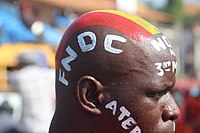2019–2020 Guinean protests
| 2019–2020 Guinean protests (FNDC Movement) | |
|---|---|
 Protestors in Conakry on 24 October 2019 | |
| Date | 14 October 2019 – 31 October 2020 |
| Location | |
| Caused by |
|
| Goals |
|
| Methods | riots, general strike, ghost towns |
| Resulted in |
|
| Deaths and injuries | |
| Death(s) | 79–85+ |
| Injuries | 144+ |
The 2019–2020 Guinean protests, or the Front National pour la Défense de la Constitution (FNDC), were a series of violent protests and mass civil unrest around
Background
In Guinea, political dissent has been silenced since the
Slogans
The demonstrators are demanding in the first place the non-candidacy of Alpha Condé for a third term and the non-modification or the new constitution in Guinea. Crazy, Crazy, crazy, Go Away, Alpha Conde, No New Constitution Until You're Gone! were popular slogans during the popular movement and widespread demonstrations.
Protests leading up to Constitutional Referendum
Protests against the referendum in the buildup to polling day led to the deaths of over 32 people between October 2019 to March 2020, with regular protests taking place in Conakry and other cities including Labé, Mamou, Boké or Nzérékoré.
During the protests, several government offices, schools and police stations were attacked with the aim of destroying voting materials. Some of the scenes that took place during that period included attackers entering a police station in Mamou and tearing up voter lists and ransacking boxes of electoral cards; two schools that were planned to be used as polling stations were set on fire; several administrative buildings in the north and southern part of the country were also set on fire; and in Labé, tyres were burnt in the streets and road barricades set up.[4][5]
On September 18, 2021, four figures from the National Front for the Defense of the Constitution (FNDC) returned to Guinea. These fierce opponents of constitutional reform and Alpha Condé's candidacy for a third term had fled abroad. Almost two weeks after the coup, Ibrahima Diallo, Sékou Koundouno, rapper Djani Alfa and blogger Fodé Sanikayi Kouyaté were greeted as heroes by a huge crowd in Conakry.[6]
Protests
Between 14 and 15 October, a wave of protests struck
Tanks and soldiers stormed cities as nationwide strikes erupted. Between 20 and 28 October, various acts of
Acts of violence rampaged through cities and poor suburbs in towns across Guinea as anti-government rallies spiraled out of control. Tens of thousands of opposition supporters and workers took to the streets, demanding better wages and pay-checks to resume. Economic turmoil and political crisis were among of the causes of the civil unrest. A conflict between protesters and the police occurred when blockades were broken down by the army, and security forces opened fire on protesters, killing at least seven in December alone.[9]
Mass rallies occurred in Guinea on 16–17 January. Two were killed in the ensuing crackdown. On 30–31 January, mass protests killed four when thousands threw stones and chanted anti-government slogans against the prime minister. Police brutality complaints were filed in court. The
After a nationwide lockdown banned protest actions and gatherings, hundreds defied the ban and took to the streets as a continuation of the protest movement. One person was injured as teargas was used to disperse protesters. Riot police stormed compounds and neighbourhoods on 20–31 July.[11]
After a break, nationwide rallies led by the opposition took place. Ten were killed in the pre-election protests demanding that president
A series of nationwide anti-government strikes intensified after the announcement of the results of the 2020 Guinean presidential election. Protesters threw stones and pelted eggs, demanding democratic reforms and justice for those who had died due to political unrest, free elections and a new government led by the opposition. Four were killed by violence from military forces against strikers and protesters. After a week-long series of protests, protesters were calm after 23 were killed by police forces who attacked protesters and journalists calling on freedom and fair elections.[13]
Gallery
-
24 October 2019 protests in Conakry
-
Protester
-
Bus looted during rioting
-
Tuk-Tuk surrounded by demonstrators
-
A protester draped in Guinea flag
-
Manifestations inNzerekoreand protester in Nzerekore
-
Drones used to hover protests
See also
- 2007 Guinean general strike
- 2009 Guinea protests
- 2013 Guinea clashes
- 2019–2020 Liberian protests
References
- ^ "Timeline: A year of bloody protests in Guinea". Al Jazeera. 14 October 2020.
- ^ "Guinea: Fears of more arrests as at least four killed in protests". Amnesty International. 14 October 2019.
- ^ "Guinea elections: Alpha Condé wins third term amid violent protests". BBC. 24 October 2020. Retrieved 5 January 2021.
- ^ Buildings torched in Guinea ahead of referendum Bangkok Post, 22 March 2020
- ^ At least 10 dead during Guinea referendum: opposition Bangkok Post, 23 March 2020
- ^ Guinée: retour triomphal à Conakry pour quatre opposants à Alpha Condé Radio France International, 18 September 2021
- ^ "Guinea: End Crackdown on Opponents to New Constitution". Human Rights Watch. 18 October 2019.
- ^ "Guinea protesters wounded by gunfire in clashes with police". France24. 4 November 2019.
- ^ "Guinea protests turn bloody in fight to stop president's third term". The Guardian. 17 December 2019.
- ^ "Guinea: At least 50 people killed with impunity during protests in less than a year". Amnesty International. 1 October 2020.
- ^ "Anti-Conde protests: clashes as Guineans return to the streets". AfricaNews. 22 July 2020.
- ^ "Guinea: Protests as Conde Files In 3rd Term Candidacy". AfricaNews. 4 September 2020.
- ^ "Guinea's president wins third term amid widespread protests". The Guardian. 24 October 2020.







